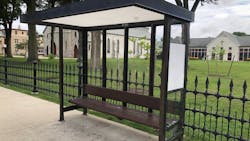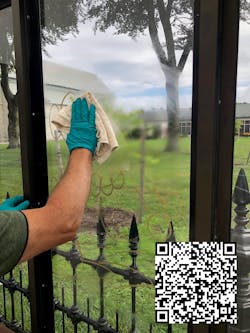OP-ED: Break the cycle of glass replacement in transit shelters with coated polycarbonate glazing
Shattered glass, unsightly graffiti and cracked laminated glass in panels used in transit shelters can negatively impact rider experience. Repeatedly replacing panels can feel like a never-ending task, let alone the significant costs and time associated with clean-up. Maintaining the appearance and effective protection of a transit shelter is essential to provide a sense of safety and comfort.
The issue has a proven but often overlooked solution. To gain the greatest value from new and upgraded shelters, transit organizations and municipalities should carefully weigh the pros and cons of different glazing materials including those beyond traditional tempered or laminated glass. Options include advanced plastics – in particular, coated polycarbonate (PC) sheet. Although coated PC glazing may not be as familiar as glass, it represents a true disruption of the status quo in transit shelters.
Why coated PC glazing surpasses glass
Glass and coated PC sheet are both transparent materials that offer visibility and protection against the elements. They also provide excellent flame retardance and mechanical property retention at elevated temperatures, however, this is where their similarities end.
The first critical difference involves maintenance, which can significantly affect the budget of a transit organization. As public structures, many transit shelters experience vandalism and breakage, as well as new forms of graffiti such as acid etching. In turn, the presence of vandalism creates a sense that the area is neglected, or worse, dangerous.
While glass can be easily shattered or cracked, requiring time-consuming repair or costly replacement, coated PC glazing is 250 times more impact resistant than glass. Further, a special, chemical-resistant surface coating can make it easy to remove graffiti even with non-toxic cleaners andprevents yellowing of the glazing panels, which can be maintained with a combination of mild soap and water. This PC glazing solution also provides protection against ultraviolet (UVA and UVB) radiation to shield shelter users.
Another important advantage of PC glazing is its lighter weight. At the same thickness, PC sheet is one-half the weight of glass, making it much easier to transport, handle and install. Therefore, a structure with PC glazing requires less load-bearing capacity than comparable glass panels, which can greatly reduce construction and installation costs.
Manufacturability is another differentiator. Coated PC sheet is easier to fabricate than laminated or tempered glass. Extrusion technology used for PC glazing is much simpler than the multi-step process required for laminated glass (heating and compressing interlayers in an autoclave). Polycarbonate sheet can be pre-cut for easy installation and can utilize existing gaskets and framing to offer significant savings versus replacing a shelter.
Since visibility is one of the top prerequisites for a transit shelter, it is important to find a glazing material that maintains excellent clarity under harsh conditions. A sheet with an abrasion-resistant coating can withstand abrasion, does not allow paint or adhesives to penetrate its surface and, because of the material’s high contact angle with water (93 degrees versus 17 degrees for glass), the silicone hard coat repels moisture better than glass, helping to maintain clarity.
How the BRTA benefits from coated PC glazing
In 2021, the Berkshire Regional Transit Authority (BRTA), based in Pittsfield, Mass., retrofitted two transit shelters with LEXAN MARGARD MR10 sheet to replace standard, uncoated PC glazing. Robert Malnati, BRTA administrator, was delighted with the results.
“The clarity is amazing. Bus drivers have commented on the improved visibility, enabling them to see into the shelters more easily as they travel their routes,” Malnati said.“In heavily used areas, breakage can be a common occurrence. Replacing glass panels becomes expensive when factoring in cleanup, installation time and materials. In addition, graffiti cleanup is faster and easier when using coated polycarbonate compared to glass or other plastic surfaces. Even after removing graffiti numerous times, these shelters still look great today.”
A related benefit to CP glazing is keeping up with graffiti removal has discouraged vandals, who apparently are looking for more-permanent locations to tag. This effect is borne out by studies. For example, the U.S. Department of Justice found “Quickly removing graffiti from publicly visible spaces is one of the most effective means of discouraging it.”
At a strategic level, shelter enhancements reflect positively on any transit organization. ,
“Our bus shelters are an extension of the BRTA. Customer satisfaction and ridership tend to increase if shelters are welcoming instead of dreary, clean instead of graffiti laden, and above all, are safe places to wait for a bus,” Malnati said.
Cost considerations for coated PC glazing
While there is a perception that PC sheet is more expensive than glass, many factors can affect total cost of ownership (TCO) of transit shelter glazing.
As the price of glass has increased due to higher labor, material and energy costs, coated PC glazing has become even more attractive in comparison. According to Glass Magazine, as of May 2022, the Producer Price Index for flat glass was up 22 percent during the course of two years. Added to this factor are the superior performance and durability of coated PC sheet (high impact resistance, easy cleaning), which drive down maintenance and replacement costs compared to glass.
Conclusion
As transit ridership returns to, and in some places even exceeds pre-pandemic levels, transit authorities can encourage this trend by ensuring shelters are attractive, safe and welcoming places. The glazing materials used in transit shelters play a key role in achieving this goal. Choosing coated PC glazing can help transit authorities maintain clarity and cleanliness while avoiding costly repairs and replacement that are common with glass.
About the Author

John Ryall
Specialties Glazing Leader for the Americas within Functional Forms at SABIC.
John Ryall is the specialties glazing leader for the Americas within Functional Forms at SABIC. He has 12 years of experience in polycarbonate glazing. In this role, Ryall supports the development of safe, compliant and competitive solutions that are well-suited for transit authorities and other industries with a focus on safety glazing.

